|
Princess of On
Esoteric interpretations of "words spoken by Osiris"
Its true that the Nauvoo publication of the
"Book of Abraham" involved "A TRANSLATION of some ancient Records
[more than one] ... from the catacombs of
Egypt" (Book of Abraham, Introductory Paragraph);
but there was no papyrus scroll written by Abram among the ancient Egyptian records that
Joseph Smith interpreted.
The
Book of Abraham as published by the
Prophet Joseph Smith, is an inspired augmentation, a
redacted and amplified restoration of an ancient text that was written by Abram "while he was in Egypt".
But neither the original, nor a papyrus copy of Abram's writing came by
mummy to "Latter Day" Kirtland, Ohio.
According
to the
Bible, the Hebrew prophet was not called "Avraham"
(Abraham) when he sojourned in Egypt. He went by "Avram" (Abram) then.
(Bereshit (Gen.) 11:17-18)
Joseph Smith later replaced
"Abram"
appearing in earlier Book of Abraham manuscripts, with "Abraham",
even though the Prophet knew that this change constituted an anachronism.
We now know that attempts at "TRANSLATION"
culminating in the work "purporting to be the writings of Abraham",
actually drew from:
(1) portions of the Hor
Book of Breathings
,
(2) a round talismanic illustration
(hypocephalus)
accompanying the Sheshonq
Book of the Dead
(including a
papyrus solar barge illustration copied from the lady Ta-sherit-Min's Book of
the Dead), and
(3) a few symbols from the Amenhotep Book of the Dead,
the inspired interpretation of which seems to connect with the account of "the daughters of Onitah"
recorded in
Abraham 1:11.
Joseph Smith’s introduction to the Book of Abraham published in the March 1, 1842
edition of the Times and Seasons newspaper
All the Egyptian documents that came into the
hands of Kirtland "Latter Day Saints" were funerary documents - the kind
of texts one would expect to find accompanying Egyptian mummies from
Ptolemaic times. No Hebraic scrolls
arrived with the
mummies. This fact directly contradicts the sensational claims that
Oliver Cowdery
let loose from the press. (Messenger and Advocate, "Egyptian Mummies and Ancient Records",
December 1835)
Elder Cowdery wrongly identified the Ta-sherit-Min Book of the Dead
as the writings of the biblical patriarch Joseph. According to
Brother Cowdery, the ancient text appeared to him to be written in a form of Hebrew. The scroll is actually written in
hieratic Egyptian.
There was no scroll of Yoseph with the mummies. Such
sacred Hebraic writings had long been lost to the world, and it would take
something other than 19th Century
Egyptomania to
restore them. It would take what the Prophet Joseph Smith called
"present revelation"!
(Hauglid, Brian M. “THE BOOK OF ABRAHAM AND THE
EGYPTIAN PROJECT: “A KNOWLEDGE OF HIDDEN LANGUAGES”)
LDS Scripture and the Joseph Smith
Papers do not state that the Prophet had an ancient scroll of the Book of Abraham
in his possession. The simplistic idea that the Book of Abraham was found on a mummy, was publically communicated by other brethren. Dubious
statements on the subject (not clearly coming from Joseph Smith) found
there way into LDS works like the redacted History of the Church -
which has become something of an
embarrassment to LDS scholars. The references to HC vol. 2, pp. 235,
236,
348-351 have been removed from the current, revised,
and edited introduction to the
Book of Abraham.
To repeat the Prophet's own words, the Book of Abraham
is a work of "present revelation".
(Times and Seasons,
“Persecution of the Prophets”, September 1, 1842, Vol. 3, pg. 902)
The coming forth of the Book of Abraham should be compared to
Joseph Smith's translation of "a record made on parchment by
John [the Apostle] and hidden up..." but brought forth (apparently without
the tangible artifact) by revelation through
the Latter-day Seer.
(LDS Doctrine and Covenants section 7)
For reasons that may in part have to do with
the interests of Joseph
Smith's audience, the revealed Hebraic pearl that is the Sepher Avram
(Book of Abram) was couched by Joseph Smith in an
anachronistic, quasi Egyptian clamshell - an intriguing but unoriginal
embellishment consisting of redacted facsimiles from more than one papyrus
scroll, none of which were made by a Hebrew prophet.
None of the Egyptian
papyri date to the time of Avraham. None of them deal overtly with the
subject of the Hebrew prophet. So how could symbols from the Amenhotep Book of the Dead, for instance,
be seen to relate to an account in the Book of Abraham? To
understand this, we need to know some things about Joseph Smith's esoteric
Egyptians, the "Ah meh strah ans".
(Joseph Smith Egyptian Papers)
Order of "the Hidden Cubit"
The published Book of Abraham has three facsimiles that derive from
Egyptian funerary art. The second of these
(a redacted hypocephalus)
brings to mind a strange pearl inserted between the folds of revealed
scripture. The original
"pearl of great price"
in this case, is the Hebraic text itself. The text of the Book of Abraham
mentions only one "representation" including a set of
"figures at the beginning".
There is no mention in the scripture of two more facsimiles. The original illustration and "hieroglyphics" prefacing the Sepher Avram
are lost to the ages.
Surviving copies of the sacred text were supplemented with suitable
illustrations (reinterpreted) from available Egyptian funerary art.
Who
would do such a thing? An esoteric society determined to preserve the
Sepher Avram; a religious order claiming to be the
keepers of a legacy dating back to "ha-Mitsrim", "the Egyptians" to whom Avram
first
communicated divine, cosmological knowledge. (Josephus, Antiquities of the Jews,
Ch. II.3, Ch. VII.2, Ch. VIII.2)
These are the "Ah meh strah ans" - the name coming from the
Joseph Smith Egyptian Papers.
We are talking about an esoteric society that celebrated religious
syncretism; in particular, a society
that recognized the Hebrew GOD.
We are talking about "Egyptians" like those described in Yesha’Yahu (Is.)
19:21.
In addressing the readership of the Times & Seasons newspaper, it
is understandable that Joseph Smith would refer to the "Ah meh strah ans"
as simply "the Egyptians". This general term might with some
appropriateness apply to a variety of peoples who settled near the Nile
and its delta.
Historically, Semitic
Hyksos, and even
certain
Greeks
Though the Ahmehstrahans might have actually lived in, or near
the second
century BCE (Ptolemaic times), they apparently claimed to connect with the
Egyptians (ha-Mitsrim) of Avram’s
day. Hence the reference in Joseph Smith's
"Grammar & Alphabet of the Egyptian [Ahmehstrahan] Language"
to Abraham [Abram] being "forewarned of God to go down into Ah meh strah, or Egypt,
and preach the gospel
[b'sorah] unto the Ah meh strah ans".
Hieratic Egyptian did not exist in Avram's day. The text of the Book of Abraham appropriately makes reference to
"hieroglyphics", not hieratic
script. The esoteric, modified hieratic
of Joseph Smith's "Egyptian" alphabet, dates his
Ahmehstrahans. Consider also the fact that
Joseph Smith's Egyptians appear to have been familiar with
Hebrew and Greek.
Though they claimed to be the keepers of
terminology dating back to Adam, it is also
clear that the esoteric society utilized linguistic innovations from much later times. Some of the Ahmehstrahan
society would likely have congregated at
The esoteric word for "Egypt", "Ah meh strah" appearing in the
Joseph Smith Egyptian Papers sounds a
little like the feminine Hebrew word for "Egypt",
"Mitsraymah"
appearing in the biblical Abram account.
(Bereshit (Gen.) 12:10)
The plural patriarchal name
"Mitsrayim"
might be related to the Hebrew word "matsor"
connoting defensive or protecting borders - a bulwark
or refuge provided by a mighty river, sea or a
rock. (Yesha’Yahu (Is.) 19:6) But
"Ahmehstrah" also sounds like "amah" + "sitrah" or "amat-sitrah"
meaning "mother-city of protection (shelter, covering, hiding-place)".
The
same Hebrew spelling of the word "amah" also means handmaid, cubit or
ell.
(Devarim (Deut.) 3:11)
"Sitrah" has a Hebrew root that suggests cover, hide, conceal,
make secret.
(Devarim (Deut.) 32:38)
One may think of the scripture "..eternity was our covering
and our rock..."
(Abraham 2:16)
The Ahmehstrahans may have perceived in the spanning band of the Milky Way a great heavenly
river or arm
concealing a truer cosmic center than the known precessing pole star. It is also
possible that they perceived yet another starry forearm or cubit (amah)
"Amat-Sitrah" might then have suggested to the Ahmehstrahan mind the
veiled cosmic
heart, the hiding place of Deity (the Elohim), the divine protecting arm, the
celestial cubit, the
covered bride of the heavens.
See
LDS Scholar Ed Goble,
"Kolob Character Comparisons, Visual Affinities and Mythological Background".
See also "Meanings of Kolob" at the end of Ahmehstrahan
Counting and Gematria
.
"Egypt" to the Ahmehstrahans, may have been seen as an
earthly imitation, a reflection of things they perceived in the heavens.
The Prophet Joseph Smith was inspired to do what the Ahmehstrahans
did in preserving, and enhancing their version(s) of the ancient Sepher Avram.
Joseph, like the Ahmehstrahans of old, borrowed from available Egyptian art a suitable substitute for the long lost "representation at
the commencement" of the Sepher Avram.
(Abraham 1:12-14)
Joseph Smith was inspired to see in the first
vignette of the Hor Book of
Breathings the desired replacement, which he adapted.
This is how the Book of Abraham started.
Beyond this, the
first English manuscripts of the
Book of Abraham show strange
correspondence between the Book of Abraham text and samples of
Egyptian characters copied from the commencement of the
Book of Breathings.
The same kind of esoteric correlation exists between badly copied
hieratic
characters from the Amenhotep
papyrus (a separate scroll), and a revealed account having to do with the
Book of Abraham's "Onitah" or rather
"On-i-tas"
(spelled "Onitas"
in the Grammar and Alphabet of the Egyptian [Ahmehstrahan] Language,
pg. 5).
This strange correspondence is not a direct translation. It should be abundantly clear from the sparse selection of Egyptian
characters tied to
Joseph's "Translation", that the Prophet did not regard the Hor Book of Breathings, or any of the other papyri
at hand, as the actual source of the Book of
Abram.
Let us take a look at the so called "translation" performed by Joseph
Smith on the meager selection of symbols from the Amenhotep Book of the Dead.
Sadly, the original papyrus is no longer available. On the subject of this text, LDS Scholar John Gee
stated, "Some of
the Book of the Dead of Amenhotep, son of Tanoub, is preserved only in a
terrible copy in the Kirtland Egyptian papers
Egyptian manuscript no. 6. ...
The Ptolemaic hieratic has been copied by one of the brethren in Kirtland who
had no idea what he was copying and did not recognize the same sign when he
saw it again." (Gee, "A History of the Joseph Smith Papyri and Book of
Abraham", FARMS, Book of Abraham Lecture Series, 1999, pg. 10)
Copy of hieratic characters from the Amenhotep
papyrus (read right to left), 1835
Proposed transliteration (read left to right) of the above Amenhotep
text. Ritner, The Joseph Smith Egyptian Papyri - A
COMPLETE EDITION, pg. 259
Joseph Smith's
authoritative signature appears at the
beginning of the "Valuable Discovery ..." note book containing the characters copied from the Amenhotep Book of the Dead.
Professor of Egyptology
Robert K. Ritner
has identified the hieratic symbols
"some in mirror image" (flipped)
associated with Joseph Smith's
"Translation".
Hieratic
characters copied from the opening line of the Amenhotep papyrus, 1835
The same (but modified) hieratic characters, "some in mirror image", in
relation to Joseph Smith's
"Translation"
, 1835
Transliteration of proposed Egyptian
characters associated with Joseph Smith's "Translation", 1835. Ritner, The Joseph Smith Egyptian Papyri - A
COMPLETE EDITION, pg. 260
Transliterating and then translating these hieratic characters, Ritner presents us with:
dd mdw
in wsir
"Recitations by Osiris". (Ritner, The Joseph Smith Egyptian Papyri - A
COMPLETE EDITION, pg. 259-260)
It just so happens that the same Egyptian words appear above the raised
hand of the goddess
Maat (who
serves to represent a "Prince of Pharaoh" in
Book of Abraham Facsimile No. 3, Fig. 4.) depicted in the last vignette of
the Hor Book of Breathings.
What do these hieratic characters look like when transcribed into Egyptian
hieroglyphs? LDS Scholar Michael D. Rhodes has performed the much appreciated
service of converting the hieratic signs to hieroglyphic Egyptian. (Rhodes, The Hor Book of
Breathings - A Translation And Commentary, pp. 24-25):
The hieroglyphic transcription more or less reads from top to bottom, right to left (transliteration in blue):
On the right is an academically accepted translation of the symbols that
the Prophet Joseph Smith interprets as meaning, "Prince
of Pharaoh
.."
as written above the hand of the goddess of truth in
Book of Abraham Facsimile No. 3, Fig. 4. (Hor Book of Breathings, last
vignette)
As if that weren't perplexing enough, the Prophet Joseph relates the same
Egyptian characters (also appearing in the Amenhotep papyrus) to the epitaph of a "Princess, daughter of On-i-tas
Pharaoh King of Egypt...".
See Ritner's transliteration above.
What in
heaven's name is going on?!!
Lets make a list:
(1) First, note that the sense in which the hieratic Egyptian is read appears to
have been understood by the Prophet Joseph Smith.
The hieratic, like Hebrew, or like the apparent movement of the lunar phases (viewed from
earth's northern hemisphere), progresses right to left. Joseph
Smith got this right despite the "terrible" copying jobs performed by
his unwitting scribes.
(2) Egyptian characters can be read in mirror image (flipped) format.
Joseph Smith appears to have grasped this as well.
(3) While Facsimile No. 3, Figure 4. has a female standing in for a
"Prince", the Joseph Smith "translation" from the Amenhotep's papyrus seems to associate a "Princess" with a male!
The thing that is common to both cases is that Joseph seems to recognize in the
apparently versatile symbols the theme of a child of Egyptian royalty.
(4) Notice that the title "Pharaoh"
is struck from Prophet's ostensible "translation" of the characters. The use of the title
"Pharaoh"
describing a king of Egypt, is an anachronism in both the biblical
Abram, and Book of Abraham
accounts. Both accounts appear to be redactions of older writings. The
biblical reference to "Pharaoh's house", or "bet Par'oh"
(Bereshit (Gen.) 12:15)
is something of a redundancy, in as much as "Par'oh" in
Egyptian means "Great
House". (See for instance "Pharaoh", LDS BIBLE DICTIONARY)
What follows is the textual correlation ("Translation")
that the Prophet Joseph Smith made with hieratic symbols (transcribed
below as hieroglyphs) from the Amenhotep papyrus
(transliteration in blue):
The Egyptian temple banner hieroglyph
Curiously, in the Kirtland "Valuable Discovery ..." notes, the banner symbol
is separated from "Wsr" (Osiris), and is combined with the
Ritner ignores the fact that the banner symbol is combined with the
Notice how few Egyptian characters accompany the Katumin text. You don't
have to read
hieratic
or hieroglyphic Egyptian to discern that the Egyptian symbols are
not the source of the text. Joseph Smith probably didn't think the
Egyptian characters were the source of the text either.
The numbers alone, cited in the epitaph, are more than the Egyptian symbols can account for.
The numbers mentioned in the Katumin epitaph are:
2962, 30,
28,
3020.
Except for a possible correlation between the copied hieratic
characters
Here is how the Prophet Joseph Smith represented the number 28 in Ahmehstrahan Counting:
28 is the age of the Egyptian princess when she died!
Here the prophetic representation of the number 2
This appropriately spells the numerical name
"Ni".
This
also happens to be the reverse of the Egyptian word "in", read in the
opening line of the Amenhotep text.
The prophetic symbol for 2
Both the
Ahmehstrahan counting system
and
standard Egyptian numerals are base 10
systems. Neither system uses
zero as a numeral place holder. Despite
their connections to hieratic letters, and possibly also
hieratic numerals, Ahmehstrahan
counting symbols appear similar to
"Arabic numerals"
of Northern Africa.
See Ahmehstrahan
Counting and Gematria
The Prophet likely believed that the Egyptian signs on the papyrus only
correlated with the revealed Katumin text, and that the signs did not
completely contain the Princess' epitaph.
But not willing to grant so much common sense to Joseph Smith, Ritner cynically
huffs, "Thus Smith's elaborate translation
corresponds to only the first four words of [the Amenhotep text]"
Ah, but what might multilingual Ahmehstrahans have seen in these
few Egyptian symbols?
The repetitive "d"
sounds in "dd mdw" calls to mind the Hebrew
equivalent "devarim
diber" = "words spoken".
Each of the Egyptian picture symbols (hieroglyphs) can be related
to a Hebrew word which the hieroglyph depicts. Let each hieroglyph stand
for the first letter in the Hebrew word associated with the picture, and then
let us
see
what word(s) the group of symbols spell out.
This approach is comparable to
spelling Semitic words using the
Protosinaitic aleph-bet.
Although, we
will come to see that the Ahmehstrahan assignment of
Hebrew letters to Egyptian symbols is more variable. The Ahmehstrahans
became very adroit at expressing their religious syncretism through a
kind of esoteric
polysemy.
Interpreting Egyptian symbols the Ahmehstrahan way, is comparable to solving quadratic, or even higher order equations. Such
equations typically have more
than one solution (by analogy: interpretation or theme). A musical analog might be
found in
a
Bach fugue - with its polyphonic, multiple
musical melodies, masterfully played together.
Its ok for a verse or set of symbols to have several different
meanings!
In the case of "words spoken by Osiris" written above the hand of the
goddess Maat (as depicted in
Book of Abraham Facsimile No. 3),
one can envision a staff, or
sign pole (Heb. "nes",
נס) with a fiery serpent (Heb. "saraph",
שׂרף),
the ripples of the Nile (Heb. "Y'or",
יאוֹר), and a papyrus reed (Heb. "eveh",
אבה).
Appropriately rearranging the column of characters (in Facsimile No. 3)
into a row, and taking the first letter of each word, a Hebrew word for "prince"
appears: "n'si" (נשׂיא), as in "n'si Elohim",
"prince of God(s)" - a description bestowed on Avraham by the
children of Het (Heth).
(Bereshit (Gen.) 23:6)
The Hebrew/Egyptian characters may then be interpreted to read "prince of
god Wsr
(Osiris, Pharaoh in the after life)" which can be seen as a
reference to the sky god Horus (Hor).
Hor happens to be the name of the owner of the papyrus Breathing Permit!
For more meanings and discussion of Facsimile 3 see "JOSEPH SMITH LEARNS
TO THINK LIKE AN AH-MEH-STRAH-AN" at the end of Note 4, in
"Abraham in Egypt and the Papyrus Solar Ferry"
But how might a "Princess" be seen in these same symbols?
Look again at the first Egyptian
sign correlating to the first line of the Joseph Smith Amenhotep "Translation":
Hebrew wordplay occurs frequently in the Bible. Consider
the words "sarey Par'oh" translated "princes of Pharaoh". The word "sarey" may be seen as a
play on words with the name of Avram's wife "Sarai" in the
peccant scene of Bereshit
(Gen.)
12:15.
The Eternal
would later take a letter "hey" (ה)
from his own name and change "Sarai" to "Sarah"
(שׂרה), "Princess".
Reading "saraph" as "Sarat ...", "Princes of ...", does seem to
correlate with the first line of the epitaph: "..Princess ... of On-i-tas
..."
The Ahmehstrahan symbol
What about the characters correlated with the next line of the Katumin
epitaph? Here they are in hieroglyphic form:
The equivalent copied hieratic symbols in Joseph Smith's "translation" of this line are grouped in a curious
manner. They are in reverse order
Let
Another Hebrew word for "reed"
The "walking stick hieroglyph"
Thus the Hebrew word "nasa"
(נסא)
with the rare but acceptable spelling "nun", "samakh", "aleph" arises.
This word means lift up, raise up, or exalt
as in raising up a "n'si", an "exalted one", "prince", "chief"
or "ruler". The ascension of a king can be suggested.
The ancient word "nasa"
thus seems to tie in nicely with its associated
line "who began to reign ..." in Joseph Smith's Katumin epitaph.
The otherwise strange association of the banner symbol
Whereas the letters "nun"
The "banner" ("ntr" in Egyptian), "nes" (in Hebrew), spelled "nun, "samekh"
,
נס
is therefore appropriately connected to the letter "nun".
It is literally
combined with the n-water ripple symbol in the Kirtland
"Valuable Discovery ..." notes. There is in fact both a Hebrew and
Egyptian justification for this tie.
Lastly, we see the name of Osiris, the resurrected judge of the dead "Wsir"
The name "Wsir" incorporates the "throne"
symbol, and correlates with kings of Egypt and the afterlife. These symbols
appropriately touch upon the last line of the epitaph: "...
born in the 30th year of the reign of her father,
and died when she was 28 years old ..."
There is more to be seen in these symbols, but we should first restore
them to the order in which they appear in the Egyptian texts:
We have seen how the composite character
It is understood that "sarah",
"princess" is an "exalted person" -
lifted up. So we have both a phonetic
correlation (similar sound) and a thematic correlation (being lifted up).
We
may also recall an instance in Hebrew scripture in which a "rod", "staff" or
"shaft" became a "serpent" ("nahash", Shemot (Ex.) 4:2-4).
Thus both symbols together may connote either the raised "saraph" (i.e. Bemidbar (Num.)
21:8), or potentially, serpents (more than one); in that when the rod is cast down on
the ground it becomes another serpent.
Note the similarity between the Hebrew word "mateh" (מַטֶה),
translated "rod" in Exodus 4:2-4 (KJV), and the Egyptian
Choosing to see the
serpent/pole sign
CHALLENGE:
To see if the transtextual correlations between Egyptian and
Hebrew are stronger in Joseph Smith's "translations" than between Egyptian and Greek, here is an
exercise worth attempting:
Start with the Greek word "ophin"
(όφιν) translated
"serpent" in ST John 3:14 (KJV).
This word describes the messianic symbol lifted
up by Moses. Investigate Greek words befitting of the
characters in "dd
mdw in Wsir". See if any significant correlation in Greek can be found
relating to the Katumin text, or to
Book of Abraham Facsimile No. 3,
Fig. 4.
Continuing:
Thus
Egyptian syncretism, however, synthesized the resurrected god
Osiris with the creator god
Ptah. The Ahmehstrahans
had the option of seeing Ptah superposed with, or in place of Osiris.
They could then have read:
It happens that the banner hieroglyph
Moreover, the throne symbol
Thus
"... Coming down in lineage, in a line by onitas
one of the royal families of the Kings the of Egypt." (Grammar and Alphabet of the Egyptian [Ahmehstrahan] Language,
pg. 5)
Let us also remember that "saraph" (שׂרף)
sounds strikingly like "Sarah
aph" (שׂרהואף),
meaning "Princess also". In fact, "Sarah aph" is a
homophone, or oronym of "saraph"
(fiery serpent). Amazingly, we may see in the Egyptian characters (read right to left):
Finally, the eye hieroglyph
In relation to the topic of the daughters of Onitah in the land of the
Kasdim, one may perceive in the symbols above, the subtle hint of a Hebrew
term for "enemy", "adversary". This same term may be seen in 1 Shemu’El
(1 Sam.)
29:4. Here the term is used in a relative sense. David was
perceived as a potential "adversary" by
the Pelishtim (Philistine) princes.
Moreover, the Hebrew word for "fiery serpent", "saraph"
(שָׂרָף)
"Now, this priest [in the service of Elkenah and Pharaoh]
had offered upon this altar [in the land of "Chaldea" (Kasdim)] three virgins at one
time, who were the daughters of Onitah, one of the royal descent directly
from the loins of Ham. These virgins were offered up because of their
virtue; they would not bow down to worship gods of wood or of stone,
therefore they were killed upon this altar, and it was done after the manner
of the Egyptians." (Abraham 1:11)
A portion of a vignette (upper right-hand
corner) from the lady Nefir-ir-nebu's Book of the Dead (Joseph Smith Papyri).
Conflating the
vignette
with the lady Ta-sherit-min's Book of the Dead,
Oliver Cowdery alleged this vignette to be part of the biblical
patriarch "Joseph's record ... a representation of the judgment:
… the Savior [resurrected Osiris] seated upon his throne, crowned, and holding the sceptres [scepters] of righteousness and power,
before whom also, are assembled the twelve tribes of Israel, the nations, languages and tongues of the earth,
the kingdoms of the world over which satan is represented as reigning.
[Prince]
Michael the archangel
[Maat, goddess of truth and justice, above whose hand is written "words spoken by Osiris
..."], holding
the key
[ankh] of the bottomless pit,
and at the same time the devil as being chained and shut up in the bottomless pit."
(Messenger and Advocate, "Egyptian Mummies and Ancient Records",
December 1835)
"words spoken by Osiris ..." above the hand of
the
goddess of truth and justice.
Vignette from the
lady Nefir-ir-nebu's
Book of the Dead
(Joseph Smith Papyri collection).
Hebraically sensitive Ptolemaic Egyptians could have seen in the serpent on a pole motif and logo (which in Egyptian literally means “spoken words”), a monogram of the divine name in post exilic Hebrew. The symbols could be
esoterically interpreted to mean “the Word is
Yah” (who is also
God of the moon in Egyptian religion)
Additionally, this monogram brings to mind "Yaho – Saraph", "The Eternal [is the] Saraph" which sounds like "Yehoseph"
(Tehilim (Ps.) 81:5) meaning "the Eternal adds". The shortened form of this latter name is
"Yoseph",
meaning "he will add (gather)". The biblical mispronunciation of the Egyptian name bestowed on Yoseph, is
"Zaphnath-paaneah"
(Genesis 41:45,
KJV). Assuming that Moses actually wrote Genesis (Genesis in
fact is a redacted work), some might level the same criticism against the lawgiver
as is flung at the Prophet Joseph Smith - that he didn't know Egyptian.
Transliterated from the Hebrew, Joseph's Egyptian name is "Tsaphenat-pa’neah",
but the actual Egyptian pronunciation could be closer to “D(d)–pnt(r)–ef–nh"
or "De-penute-ef-onh". The Egyptian name means "the god speaks and he lives". Joseph’s Egyptian name may therefore begin with the serpent symbol.
(Brown-Driver-Briggs-Gesenius Hebrew-Aramaic Lexicon 6847, pg.
861. See also Bereshit (Gen.) 44:15:
"... a man as I can certainly divine
["nahash", observe signs;
hissing serpent] ... ", and LDS Bible Dictionary, Zaphnath-paaneah,
"he who reveals that which is hidden")
Correlating
Recognizable Egyptian with
Esoteric Ahmehstrahan
In addition to knowing Egyptian, Hebrew, Greek, etc. the Ahmehstrahan
society developed there own esoteric system of symbols. This "language"
employed
modified, and reinterpreted hieratic characters.
The fact that Joseph Smith gave different
interpretations in relation to the same Egyptian words (e.g.
"dd mdw in Wsir") shows that the Prophet's inspired
lists and notes on the Ahmehstrahan language do not guarantee unequivocal, exclusive translations.
Just as Hebrew correlations can be made wth "words spoken by Osiris"; manifesting a "Prince ..." in one case, and in another
case a "Princess ...", so it will be seen that in correlating the same
Egyptian symbols with Ahmehstrahan, both a "princess" and a "prince"
appear as potential interpretations. Polysemy
is involved, whether we are trying to correlate Egyptian symbols
with Hebrew, or Greek, or to the esoteric
characters in Joseph Smith's catalog.
Do not expect Joseph Smith's Ahmehstrahan notes and lists to produce the
Book of Abraham entire from symbols found in the Hor Book of Breathings, or
to produce
the complete Katumin epitaph from characters appearing in the Amenhotep Book of the Dead.
The Prophet's "Egyptian" material only aids in discovering transtextual
correlations between Egyptian characters and the texts that he received by revelation.
See Ed Goble,
"Katumin the Princess, Royal Female Lineage, and the Cobra (Iaret or Uraeus)"
The modified representation appears to be an attempt to go beyond the
serpent image and embrace a serpent crested crown or tiara. At least
this interpretation is compatible with hints given in the Ahmehstrahan
degrees:
The following selections from Joseph Smith's Grammar and Alphabet of the
Egyptian [Ahmehstrahan] Language appear to correlate with the
modified hieratic characters associated with the revealed Katumin
epitaph. These unedited selections are given to
raise the
interest of the reader - to encourage more exhaustive exploration of Joseph Smith's Grammar and Alphabet of the
Egyptian [Ahmehstrahan] Language.
That a "Crown" or serpent headdress, is suggested by the symbol
To see "Katoumun" or "Katumin" spelled out in the characters of "dd mdw in ..." we
need to return to the arrangement of the characters as they appear in
the Egyptian papyri. Remember this is not the
Also as before, the n-water ripple symbol
We therefore have "Keter-u-min" or "Keter-ou-mun". The
Hebrew pronunciation possibilities agree with the variety that Joseph Smith
revealed.
Consider
the similarity between
Thus a
Note also the Ahmehstrahan princely crown symbol
Note
that the Ahmehtrahan symbol
Ed Goble directs our attention to the symbol
Note in the above explanations, the relation between the cosmic governing power Kli flos isis, represented by
the throne symbol
Summary and Concluding Remarks:
Hebrew
Abecedarius
and Joseph Smith's Ahmehstrahan "translations"
א
All of the Egyptian art and symbols that Joseph Smith used to
supplement the revealed
text of the Book of Abraham came from more than one Egyptian
papyrus. The Prophet knew this. This is why, in his introduction to the
scripture
"purporting to be ... the BOOK
OF ABRAHAM", the Prophet used the description "A
TRANSLATION Of some ancient Records [plural] ... from the Catacombs of Egypt ..."
The Egyptian trappings of the Book of
Abraham do not date back to the prophet Abram, but more nearly fit
Ptolemaic times.
During this time period, translators at Alexandria, Egypt were hard at work on the Greek translation of Hebrew scripture,
the
Septuagint.
They had a Greek speaking audience in mind. Did the Ptolemaic Ahmehstrahans
similarly have a
goy
audience in mind? Is this one of the reasons that anachronistic, quasi
Egyptian things were added to the Book of Abram?
Surprisingly, after much annoyance, controversy, and conflict the things of
the Ahmehstrahans augmenting the Sepher
Avram, are seen to evince Joseph Smith's prophetic
connections.
But the two-edged sword of truth cuts both ways.
It divides asunder the erroneous
tradition that a papyrus scroll of the Book of Abraham
arrived in Ohio with mummies.
Joseph Smith's definition of "translation" is a prophet's definition. What is really going on with the Book of
Abraham is perhaps better
described (academically) as transtextual correlation. Even this terminology falls short
of describing transcendent connections between the ancient writings of Abram and more recent Egyptian funerary texts.
The act of interpreting a text draws on
things beyond the text itself, and it can be argued that no work is the work
of one author. Could it be that certain writings are guided
by higher intelligence, that is, by consciousness that human authors may or may not
be conscious of?
"And Joseph said unto them,
Do not interpretations
belong
unto God?" (Genesis 40:8, KJV) "He revealeth the deep and secret
things: he knoweth what is in the darkness and the light dwelleth with him."
(Daniel 2:22. KJV)
ב
Bereshit
(Gen.)
17:5 explains that the name "Avram" ("Exalted Father") with the
divine addition
of the letter "hey" (
It
may also be that by bestowing upon the Hebrew prophet part of the divine name (changing his name),
God (אל) was
putting his son (בּן) in his place. The Eternal is truly AV RAM.
(Yesha’Yahu (Is.) 63:16)
The
Prophet Joseph Smith's amplification of the Sepher Avram may
be seen to represent a broadening of the audience, an outreach to include the nations
foretold in Avraham's later, greater blessing. This inspired work thus truly became a "Book of
Abraham", "father of goyim", having a version of the ancient
original Sepher Avram at
its heart.
Transtextual correlations between Egyptian
symbols and Joseph Smith's revealed texts can be compared to
acrostic
Hebrew scripture. In the case of the Book of Abraham there are
thematic, or subject correlations between esoteric interpretations of
Egyptian symbols, and portions of the scriptural text. In acrostic
alphabetical poetry, the letters of an alphabet (in regular order),
correlate with the first letter of the first word, commencing each portion
of text (for instance in a psalm, proverb or lamentation).
Not all acrostic alphabetical psalms in the Bible
succeed in having a perfect correspondence, in regular order, with letters of the aleph-bet. Take for instance Tehilim (Psalms) 9; 25; 34; 37. Its
hard to believe that a psalm is written in the form of an
abecedarius
only to serve as a mnemonic device. No one expects the alphabetical symbols
themselves to be sufficient to supply the whole text. It is as if the writer
is moved upon to return a literary bread offering to God (an abecedarian
psalm, proverb or lamentation) based in part on grain
(the aleph-bet) which is acknowledged to have come from God.
Tehilah (Ps.)
119 is a prime example of a Hebrew abecedarius. Without inspiration the symbols
of the aleph-bet alone could not
produce this psalm. Likewise, symbols from the first few lines of the
Hor Book
of Breathings could never produce the Book of Abraham, nor the first
four words of the Amenhotep Book of the Dead reveal the epitaph of Princess Katumin.
It takes inspiration to bring forth the rest,
and inspiration suggests an author apart from the author. That's
transtextuality.
On this subject of
writing being a divine gift,
it happens that the name of the first letter of the ancient Egyptian "alphabet"
relates to the moon god Thoth,
slayer of serpents.
The Greeks identified Thoth as Hermes,
"father of letters". Some have associated this first letter by evolution of appearance (not
phonetically) with the Greek and Coptic letter α, A. (Gaudard, "Between
Heaven and Earth - Birds in Ancient Egypt", Oriental Institute Museum
Publications 35, the Oriental Institute, Chicago, edited by Rozenn Bailleul-Lesuer,
2013)
Is it only coincidence that the first word spelled
in the aleph-bet is "AV" (אב)?
"... behold, all things are written
by the Father; therefore out of the books which shall be written shall the
world be judged." (3 Nephi 27:26)
On to
See
Ahmehstrahan
Counting and Gematria
Vincent Coon
|

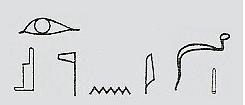 =
=
.jpg)
.jpg) =
"
=
"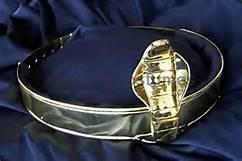

 The saraph (fiery serpent)
The saraph (fiery serpent)  may also be seen to represent "Egyptian royalty", "the
divine throne".
may also be seen to represent "Egyptian royalty", "the
divine throne".  "
"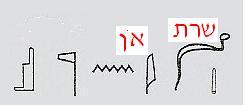 ≈ "Princess of On-ntr-as", which sounds like
"
≈ "Princess of On-ntr-as", which sounds like
"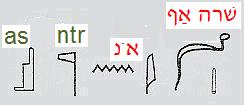 ≈
"Princess, also On-ntr-as (On-it-as King of Egypt)".
≈
"Princess, also On-ntr-as (On-it-as King of Egypt)".

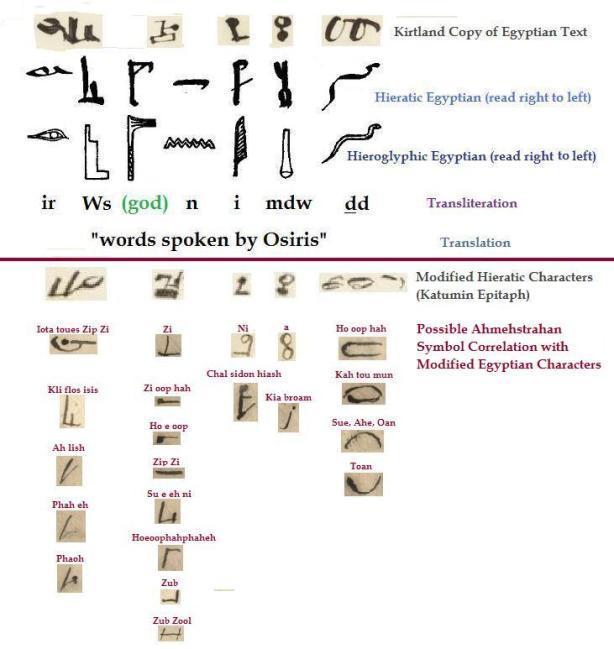
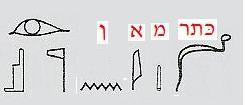 ≈
"Keter-min of the divine throne".
≈
"Keter-min of the divine throne".
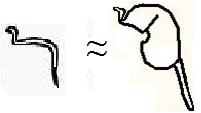
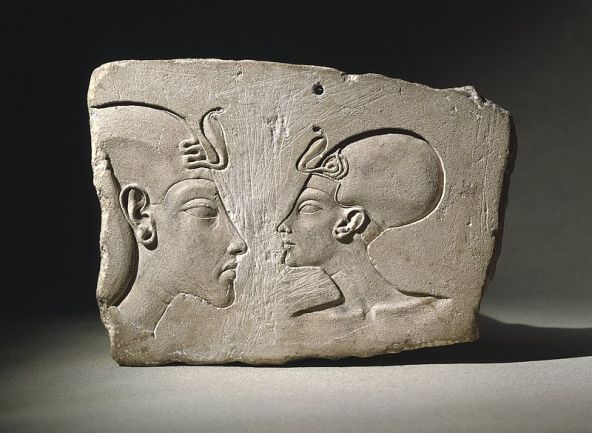
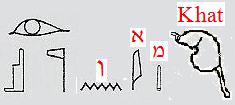 ≈
"Khat-oum-un, the divine throne".
≈
"Khat-oum-un, the divine throne".